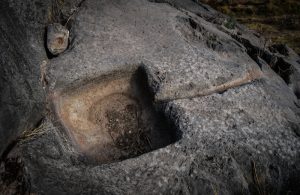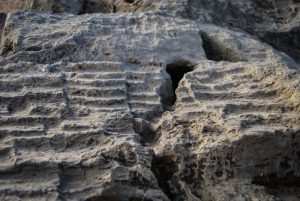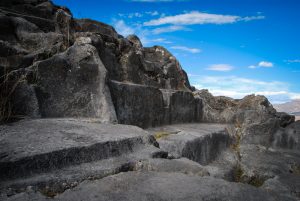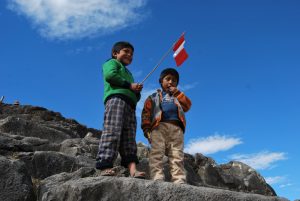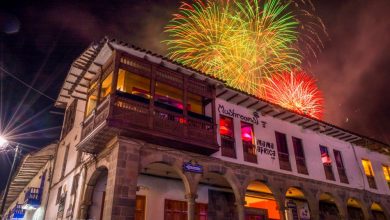A Sacred Mountain Modeled: Teteqaqa in Cuzco
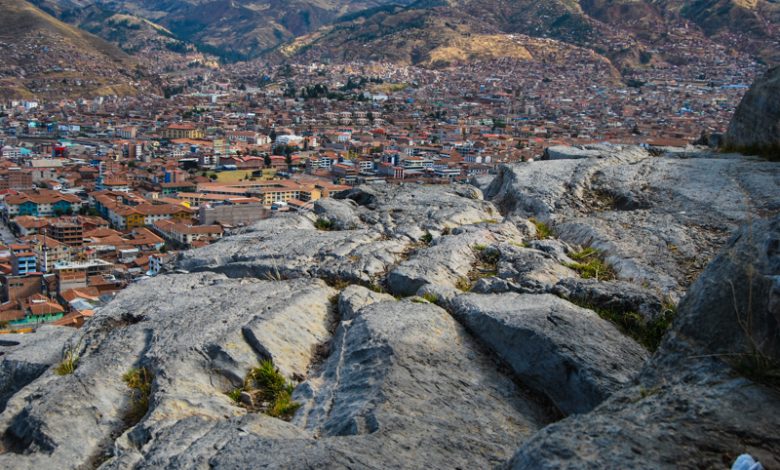
When the Incas ruled Cuzco there were shrines of greater and lesser importance all over the Huatanay Valley in which it sits,. Some of them were connected in lines of ritual called ceques, and some had temples with attendant priests and nuns who had sacred knowledge and historical knowledge that were part of an annual and daily round of ritual. Many of these places still exist in Cuzco today. Some are still holy and some are less so.
One of these places, called huacas, continues to be important today, although it is seldom visited by tourists and almost unknown to them. It combines not only the remainder of Inca worship but also is an active cult center today.
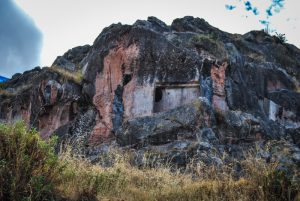
I refer to the shrine of the Cross of Teteqaqa. These last weeks the streets near it have been filled with music, dance, food and drink as those responsible for the annual round of feasting carry out their obligations.
While in Inca times priests probably ran the services and cared for a shrine that was probably as important as this–in fact, it would not surprise me if the remains of their quarters lay underneath the colonial convent and Church of La Recoleta which is at its base–the shrine is attended and cared for today by a group of faithful who rotate obligations to the cross among themselves. They are also related to the neighborhood organization of the Recoleta area and up hill.
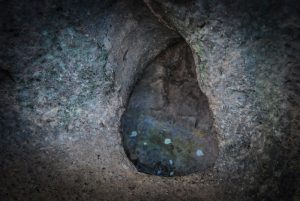
The shrine of the cross consists of some wrought iron bars painted white under an unprepossessing corrugated metal roof stretching out from a massive rock. At its base are closed boxes where, if you look through the cracks, candles burn. Buckets of flowers decorate the base from which a carefully dress wooden cross rises. It is covered in rich brocade, which also announces who is the latest sponsor of its feast, and rests backward against the cliff.

The road that runs behind La Recoleta has a tall adobe wall that separates the Church-Convent from the road. Across that asphalted path grows an Inca wall of carefully spaced, irregular stones that rise two thirds of the way up the cut of the hill that allowed the road to cross through.
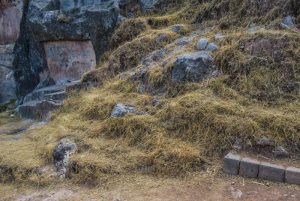
Against the Inca wall, people place trash. The area is popularly known as a basural, a garbage dump, and has signs warning people of fines for dumping.
Right above the dump rises a sign that says Teteqaqa archeological site.
Above the wall the dirt rises irregularly, as if it came to lie on top of something lumpy. With dried grass, in the winter, and greenery in the summer, the hillside would seem another one of Cuzco’s slopes. It makes you wonder what the area must have been like before the many houses grew up on the slopes.
The area is known today as Balconcillo, the little balcony. It was an area of carefully constructed terraces that rose from the valley floor. Nowadays, most of the terraces are covered with houses, although their general outline remains. Some of them still stand. However the terraces changed, as best one can tell, as they went around the massive volcanic stone that is Teteqaqa.
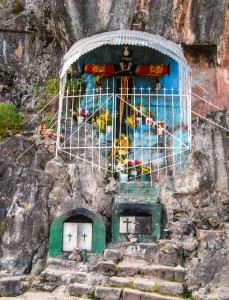
Teteqaqa was an important huaca, as one can tell by looking carefully at the massive rock, or qaqa in Aymara.
(Tete means mountain cat or puma. The cliff and site have the same name as Lake Tititcaca, even though the word is spelled differently, and as the famous cliff on the Island of the Sun from which Manco Capac and Mama Ocllo, the first Incas, are supposed to have come.)
The rock is carefully carved to make a very impressive and very complex ritual space. A description of a few features will give you an idea.
- The rock has many platforms and steps carved and polished in it. These may have been images of the universe which comes in different levels, useful for gaging the time of year, and for making ritual offerings and displays. In any case, the massive work is impressive for this alone.
- The inside of the rock has a cave with a carved stone in it that may well have served for sacrificing llamas and more. The cave (along with a cave in a nearby rock, were considered paqarinas or places of origin. The cave of Teteqaqa of Cuzco figures in the Huarochiri myths as the place from which the Inca obtained his wife, and caves in the area are said to still be inhabited by Incas.
- The massive stone has serpents carved on its sides. Serpents are important ritual animals in Andean mythology and spiritual practice.

Candles Burning in Hope (Photo: Wayra) - The site has numerous water courses carved in it, one of which seems to represent the lake at the top of a mountain from which a river flows. These lakes are still today considered the place of origin for life, as well as the source of rain and streams necessary for agriculture. One of these is on the Cerro Khapia in Yunguyo, Puno, Peru. When a mining company proposed to mine the hill a few years ago and thus damage the lake, the people of the area rose up to stop them and were successful. Such is the importance of the holy lakes, even in a model as on this rock.
- Teteqaqa has carved on its top a series of terraces with a lake and eroded stream bed separating them into two parts. This was a model of agricultural life and social life, as well as a kind of mandala, a model of the cosmos. It is delicately and precisely rendered. Beside displaying a model of the larger cosmos, it also is a model of the location of the huaca in an area of terraces.

Carvings in the Stone (Photo: Wayra) - Finally, the massive stone itself is located on a rise which, when seen from below, probably looked like a terraced and multileveled temple, as if a pyramid. Some of this is still visible in the walls that sculpted the hill and set off the enormous rock-sculpture.
- It is part of a complex that probably included the esplanade, or pata, on which Recoleta is built, as well as nearby haucas above and to the side of it, such as the Mesa Redonda and caves as well as stream.
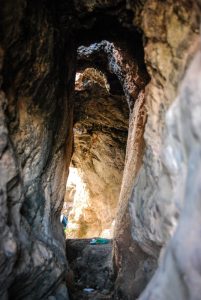
Though few tourists visit Teteqaqa, it is worth seeing for its current importance as the base shrine of the powerful and miraculous Cross of Teteqaqa, one of the most important of the crosses that organize Cuzco’s human world. And it is important as a fine example of Inca ritual stone work, as the made a model of the sacred mountain which could serve to both divine the nature of the current world and its future, as well as change the organization of life and the world. If nothing else, the sacred mountain was key for keeping food growing and preserving the harvest for people. The Cross still does this.
You can get to the Teteqaqa Arcehological zone by taking a taxi along the Circunvalación Street which rises to Sacsayhuaman from the City and asking the driver to stop at the gate to Teteqaqa.
You can also take a cab along Lucrepata until you reach the basural and then walk up a dirt path.
There is also a foot path that rises from Rosaspata. No entrance fee is charged.
